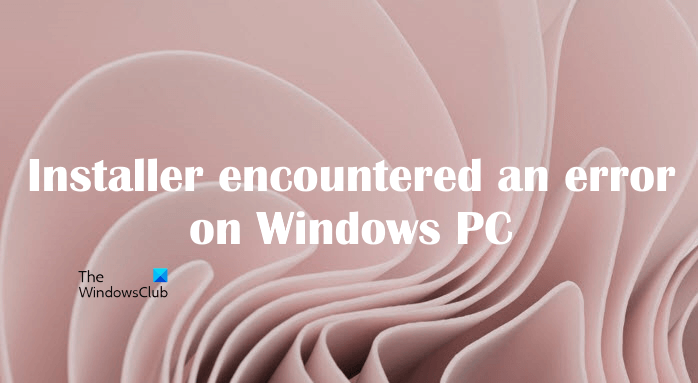This article lists some solutions to fix Installer encountered an error with error codes 0xc8000222, 0x800f0905, 0x80070422, 0x800f0905, 0x800b0109, 0xc80003f3, 0x8007000d, 0x800b010a, 0x800b0001, 0x800B0101, 0x8000ffff, etc. on Windows 11/10 computer. You may receive this error message along with various codes while installing updates on your system via Settings or Windows Update Standalone Installer.

These errors occur due to one or more of the following reasons:
- There is a log file or database corruption in the %Systemroot%\System32\Catroot2 folder.
- The Cryptographic Service is disabled on your device.
- There are corrupted or missing system files.
- The timestamp signature or certificate has malfunctioned or could not be verified.
- You do not have any appropriate certificates in your Trusted Publishers certificate store and the Enable trusted publisher lockdown Group Policy setting is turned on.
- The Software Distribution folder is corrupted.
Fix Installer encountered an error on Windows 11/10
Try the following solutions to fix Installer encountered an error codes 0xc8000222, 0x800f0905, 0x80070422, 0x800f0905, 0x800b0109, 0xc80003f3, 0x8007000d, 0x800b010a, 0x800b0001, 0x800B0101, 0x8000ffff, etc. on your Windows 11/10 computer.
- Run Windows Update Troubleshooter
- Check Date and Time settings
- Reset Windows Update Components
- Temporarily disable your antivirus
- Run SFC scan
- Empty the SoftwareDistribution folder
- Perform an in-place upgrade
Let’s have a look at these fixes in detail.
1] Run Windows Update Troubleshooter
Windows Update Troubleshooter is an automated tool from Microsoft that helps users fix problems and errors related to the Windows Update. You will find this tool in Windows 11/10 Settings. Run Windows Update Troubleshooter and let it fix the problem. After the troubleshooting process gets completed, see if you can install the updates.
2] Check Date and Time settings
As explained above in this article, these error messages also occur when Windows could not verify the timestamp signature. Therefore, we suggest you check whether the Date and Time on your system are correct or not. If not, correct the Date and Time and run Windows Update again.
Follow the below steps to check your Date and Time settings:
- Press Win + R keys to launch the Run command box.
- Type
timedate.cpland click OK. - Select the Internet Time tab and click on the Change settings button.
- In the Internet Time Settings, Synchronize with an internet time server checkbox should be enabled and time.windows.com should be selected in the Server drop-down menu. If not, do so and click on the Update button.
- Now, select the Date and Time tab and check if your Time zone is set correctly. If not, update it by clicking on the Change time zone button.
3] Reset Windows Update Components
If the corrupted Windows Update Components are the cause of the Windows Update failure on your system, we suggest you manually reset the Windows Update Components. After resetting the Windows Update Components, restart your computer and check if you are able to install the updates.
4] Temporarily disable your antivirus
Sometimes antivirus blocks Windows Updates due to which users receive several errors. This might be the case with you. We suggest you disable your antivirus temporarily and then run Windows Update again. Don’t forget to turn on your antivirus again.
5] Run SFC scan
If you have missing or corrupted system files, you will not be able to install Windows Updates. SFC (System File Checker) is a tool developed by Microsoft that scans users’ computers for missing or system files and fixes the problem. We suggest you run an SFC scan and see if it fixes your problem.
6] Empty the SoftwareDistribution folder
The SoftwareDistribution folder stores the Windows Update files temporarily. These temporary files are required by WUAgent at the time of Windows Update. If you are experiencing issues while updating your Windows computer, deleting the contents of the SoftwareDistribution folder can fix the problem.
To locate the SoftwareDistribution folder, open your File Explorer and go to “C:\Windows.”
7] Perform an in-place upgrade
If none of the above solutions fix your problem, performing an in-place upgrade may help. An in-pace upgrade installs the latest version of Windows OS without removing the previous version. The in-place upgrade is helpful if a user is receiving errors while installing the Windows Update.
How do I fix Windows installation has failed error?
There are multiple causes of Windows 11/10 installation failure, like insufficient disk space, corrupted or missing system files, etc. The error Windows installation has failed generally occurs when a user tries to upgrade the older version of Windows OS to Windows or performs an in-place upgrade in Windows.
When you receive this error message, first, you should check the minimum requirements for Windows Upgrade. If you are receiving this error message on your Windows computer, first, unplug all the peripherals and then run the update again. If this does not fix the issue, try other things like clearing the $WINDOWS.~BT installation folder attributes, rebuilding BCD, etc.
Why is Windows 11 not installing?
Before upgrading your Windows 10 computer to Windows 11, you should check the minimum hardware requirements. If your computer meets all the hardware requirements but still you are not able to install Windows 11, you should check if the secure boot and TPM 2.0 are enabled or not. Windows 11 won’t install until secure boot and TPM 2.0 are enabled on your system.
How to fix .NET Framework HRESULT 0xc8000222 error?
If you receive HRESULT 0xc8000222 error while installing .NET Framework on your Windows PC, clear the contents of the SoftwareDistribution folder as explained above and try again. It is sure to help.
I hope this helps.
Read next: Windows Update fails to install or will not download.